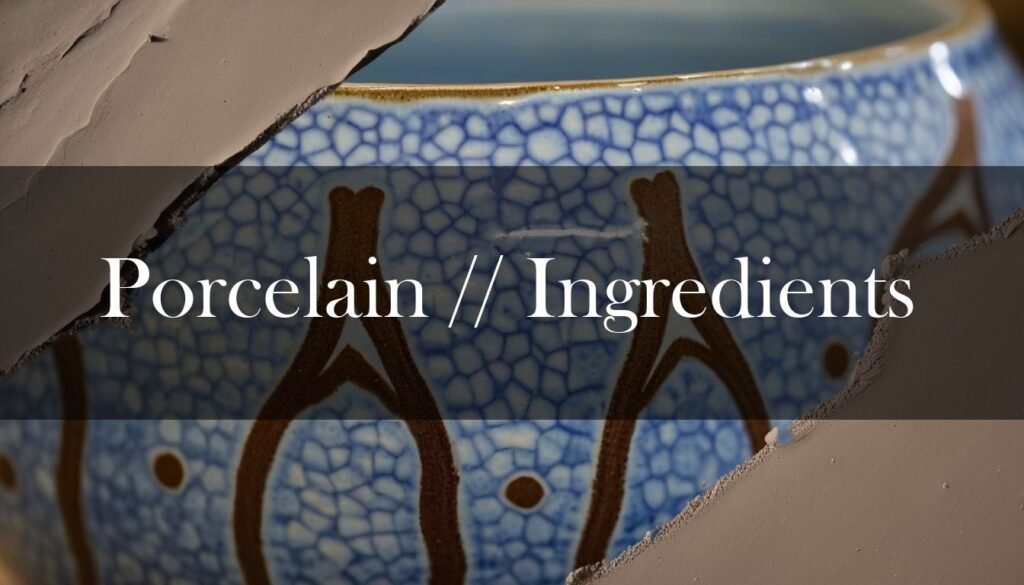Porcelain, often celebrated for its delicate beauty and remarkable strength, is a unique type of ceramic prized by potters and artists alike. But what exactly goes into making this exquisite material? The answer lies in a carefully balanced blend of essential ingredients and precise firing techniques.
The primary components of a typical porcelain clay body are kaolin, feldspar, and silica (quartz). Kaolin, also known as China clay, is often considered the most important material in porcelain. While the term “paste” was once used for both unfired and fired porcelain, today, “body” is commonly used to describe the unfired clay. Feldspar acts as a flux, lowering the melting point of the mixture and promoting vitrification during the firing process, which greatly contributes to the porcelain’s strength and translucency. As noted by ceramicartsnetwork.org, silica, in the form of quartz, provides structural integrity, acting as a filler and controlling thermal expansion to prevent cracking during firing. Digitalfire.com notes that a typical cone 10 porcelain might consist of 55% kaolin, 20% silica, and 25% feldspar, achieving a balance between plasticity, strength, and translucency, as stated by ceramicartsnetwork.org. In some cases, ball clay is added to increase plasticity, making the clay more workable, though it can affect the final whiteness and translucency. For bone china, bone ash is a key ingredient, often comprising about 50% of the mixture, along with 25% kaolin and 25% feldspar, to enhance strength and translucency, according to Wikipedia.
It’s fascinating how the interplay of these materials dictates the final qualities of the porcelain. The ratios are carefully adjusted to achieve the desired whiteness, translucency, and strength, making each porcelain recipe a unique creation.
Firing porcelain is a critical step that transforms the clay body into a strong, translucent ceramic. Porcelain is typically fired at high temperatures, generally between Cone 10 and Cone 13, which corresponds to approximately 2381°F to 2455°F (1305°C to 1346°C), according to Lakeside Pottery. Some sources specify slightly different ranges, such as Cone 8 to Cone 14 (approximately 2305°F or 1260°C to approximately 2530°F or 1390°C) (thesprucecrafts.com), or even broader ranges between 2,300°F and 2,700°F (1,260°C to 1,480°C) (kilnfrog.com). Achieving the correct firing temperature is vital because under-firing can result in a porous and weak structure, while over-firing may cause warping or melting. Historically, traditional Chinese hard-paste porcelain was fired around 1400°C (2552°F), according to Wikipedia. These high temperatures necessitate specialized kilns, such as the dragon kiln, which could reach up to 1400°C. Wikipedia also notes that during firing, porcelain clay typically experiences a shrinkage rate of about 12-15% as it loses moisture and undergoes vitrification. Digitalfire.com confirms this.
The firing process is where the magic truly happens, transforming a pliable clay body into a resilient and translucent piece. The precision required highlights the artistry involved in creating porcelain.
Porcelain’s unique properties make it incredibly versatile for various applications. It’s widely used in tableware, prized for its non-porous nature and aesthetic appeal, and in decorative items like vases and sculptures. Wikipedia notes its excellent insulating properties make it ideal for electrical insulators, a use dating back to at least 1878. Wikipedia also states that porcelain is used in laboratory equipment due to its resistance to chemical corrosion and thermal shock, and in tiles and architectural elements because of its density and smooth surface. Modern sanitary ware, such as toilets and washbasins, often utilizes vitreous china, a material similar to porcelain, as reported by Wikipedia. In dentistry, porcelain’s aesthetic qualities and durability make it suitable for crowns, bridges, and veneers, also from Wikipedia. For artists, porcelain is a canvas for intricate and delicate creations mondoro.com states, with the word “china” itself reflecting the historical significance of fine porcelain imports from China, as explained by Wikipedia.
Porcelain’s versatility is a testament to its enduring appeal. From functional items to artistic masterpieces, it continues to captivate and inspire.
An Expert Ceramist
Throwing porcelain on the pottery wheel requires specific techniques to manage its fine texture and high plasticity. Proper clay preparation is crucial, including thorough wedging, per teachinart.com.
Centering the clay involves applying equal pressure to create a strong seal with the wheel head (learning.box), while throwing requires a delicate balance of hand pressure, wheel speed, and clay moisture to prevent tearing. (crafty-clayworks.com)
Drying the piece slowly and evenly is essential to prevent warping or cracking (crafty-clayworks.com), and maintaining stability by bracing your arm and managing water accumulation are valuable tips for success (spinningpots.com). By understanding the composition, firing process, and throwing techniques, potters can harness the unique qualities of porcelain to create beautiful and functional ceramic pieces.





